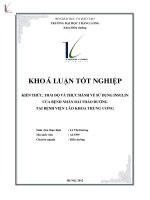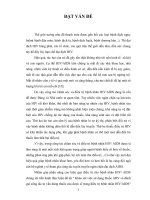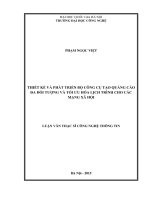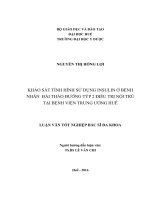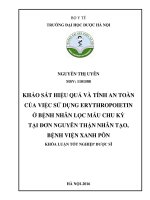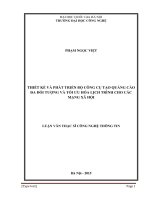CẬP NHẬT VÀ TỐI ƯU HÓA SỬ DỤNG CARBAPENEM Ở BỆNH NHÂN HỒI SỨC
Bạn đang xem bản rút gọn của tài liệu. Xem và tải ngay bản đầy đủ của tài liệu tại đây (2.02 MB, 49 trang )
<span class='text_page_counter'>(1)</span><div class='page_container' data-page=1>
<b>Updating and optimizing carbapenem use </b>
<b>in critically ill patients</b>
Paul M. Tulkens, MD, PhD
Cellular and Molecular Pharmacology
Center for Clinical Pharmacy
Louvain Drug Research Institute
<i>Université catholique de Louvain</i>,
Brussels, Belgium
18th Vietnam Association of Critical Care
Medicine, Emergency and Clinical Toxicology
Annual Congress
</div>
<span class='text_page_counter'>(2)</span><div class='page_container' data-page=2>
You said "carbapenems" ?
greater intrinsic activity due to larger instability of the -lactam ring
because of C1-C2 double bond and electrocapturing effect of the
lateral basic group
no need of a bulky "left" side chain…
<b>imipenem</b>
<b>penicillin G</b>
<b>N</b>
<b>S</b>
<b>O</b> <b>COOH</b>
<i>Penam</i>
<b>R</b>
<b>N</b>
<b>O</b> <b>COOH</b>
<i>Carbapenem</i>
<b>C</b> <b>S</b>
basic group
<b>R</b>
</div>
<span class='text_page_counter'>(3)</span><div class='page_container' data-page=3>
But imipenem is degraded by a renal dehydropeptidase
<b>imipenem</b>
<b>D-Ala-D-dehydro-Ala</b>
Imipenem (<i>t</i><sub>½</sub>1 h) is inactivated
by metabolism in the kidney by
dehydropeptidase-1 (a brush
border enzyme in the proximal
renal tubules), producing an
inactive metabolite that is
nephrotoxic.
In order to prevent nephrotoxicity
and maximize imipenem's
</div>
<span class='text_page_counter'>(4)</span><div class='page_container' data-page=4>
So, you DO need to co-administer an inhibitor (cilastatin)
<b>imipenem</b>
<b>D-Ala-D-dehydro-Ala</b>
<b>cilastatin</b>
Imipenem (<i>t</i><sub>½</sub>1 h) is inactivated
by metabolism in the kidney by
dehydropeptidase-1 (a brush
border enzyme in the proximal
renal tubules), producing an
inactive metabolite that is
nephrotoxic.
In order to prevent nephrotoxicity
and maximize imipenem's
</div>
<span class='text_page_counter'>(5)</span><div class='page_container' data-page=5>
Imipenem is ALWAYS compounded with cilastatin
</div>
<span class='text_page_counter'>(6)</span><div class='page_container' data-page=6>
Meropenem and doripenem
…
1β-methyl group
</div>
<span class='text_page_counter'>(7)</span><div class='page_container' data-page=7>
Meropenem (and doripenem) is intrinsically resistant to human
dehydropeptidase because of the 1β-methyl substitution…
Fukasawa et al. Stability of meropenem and effect of 1 beta-methyl substitution on its stability in the
presence of renal dehydropeptidase I. Antimicrob Agents Chemother. 1992 Jul;36(7):1577-9 - PMID:
</div>
<span class='text_page_counter'>(8)</span><div class='page_container' data-page=8>
Ertapenem
1β-methyl group
bulky hydrophobic
moiety
carboxylic
acid function
loss of activity against <i>P. aeruginosa</i>
(efflux)
</div>
<span class='text_page_counter'>(9)</span><div class='page_container' data-page=9>
EU- and US-approved carbapenems
<b>a</b>: similarities and differences
<b>antibiotic</b> <b>spectrum</b> <b>half-life</b> <b>resistance</b>
imipenem <b>b</b> Most Gram (+)
• except if
oxacillin-resistant (PBP2a)
• low for Enterococci
Most Gram (-) <b>c</b>
Most anaerobes
1 h
(2-20 % protein binding)
• carbapenamases <b>e</b>
• loss of porin (OprD) <b>f</b>
meropenem • carbapenamases <b>e</b>
• efflux (MexAB-OprM)<b>f</b>
doripenem • carbapenemases <b>e</b>
• efflux (MexAB-OprM)<b>f</b>
ertapenem same except <i>P. </i>
<i>aeruginosa</i> (MIC > 8) d
4h
(90% protein biding)
• carbapenemases <b>e,g</b>
• efflux <b>f</b>
<i>S</i>.
<b>a</b><sub>panipenem, biapenem, and tebipenem are approved in Japan</sub>
<b>b</b><sub>always with cilastatin</sub>
<b>c</b><i><sub>tenotrophomonas maltophilia</sub></i><sub>and </sub><i><sub>Elizabethkingia meningoseptica</sub></i><sub>are intrinsically resistant to carbapenems (class B β-lactamase)</sub>
<b>d</b><sub>due to intrinsic efflux </sub>
<b>e</b> <sub>mostly class B (metallo-enzyme; no clinically-suable inhibitor), some class A (KPC) and some class D (</sub><i><sub>Acinetobacter</sub></i><sub>)</sub>
<b>f</b><i><sub>Pseudomonas aeruginosa</sub></i>
</div>
<span class='text_page_counter'>(10)</span><div class='page_container' data-page=10>
Pharmacokinetic properties
• Unstable in gastric acid
parenteral route
• Half-life : 1 hour for meropenem and imipenem and 4.5 hours for
ertapenem
(once daily administration)• Protein binding: ~10%
• Protein binding of DHP-I inhibitor cilastatine: 35%
• Distribution: most tissues and fluids,
low concentrations occur in CSF• Elimination: renal (7.%)
• Unstable in aqueous solution at room temperature
– Degradation 10-20% in less than 3h for imipenem
</div>
<span class='text_page_counter'>(11)</span><div class='page_container' data-page=11></div>
<span class='text_page_counter'>(12)</span><div class='page_container' data-page=12>
Acquired carbapenemases
</div>
<span class='text_page_counter'>(13)</span><div class='page_container' data-page=13>
Rapid evolving resistance in Enterobacteriaceae
<b>1990</b> <b><sub>2000</sub></b>
Penicillinase
(TEM-1, SHV-1)
ESBLs
</div>
<span class='text_page_counter'>(14)</span><div class='page_container' data-page=14>
Variation of MIC in
<i>Enterobacteriaceae</i>
producing
carbapenemases
</div>
<span class='text_page_counter'>(15)</span><div class='page_container' data-page=15>
PK-PD of β-lactams …in a nutshell…
• Every antibiotic is
concentration-depedendent
(simple pharmacological principle) …
•
<b>BUT,</b>
for
-lactams, activity if already
optimal when the concentration
exceeds the MIC by 3 to 4-fold, which
is what easily happens with
conventional administration… and
bacteria with low MICs
•
<b>AND, having no post-antibiotic effect, </b>
-lactams need to stay above the MIC
(preferably 1 or even 4-fold…) for the
maximum of time…
</div>
<span class='text_page_counter'>(16)</span><div class='page_container' data-page=16>
<b>What is the relationship between MIC and effect?</b>
<b>-2</b> <b>-1</b> <b>0</b> <b>1</b> <b>2</b>
<b>-4</b>
<b>-2</b>
<b>0</b>
<b>2</b>
<b>-2</b> <b>-1</b> <b>0</b> <b>1</b> <b>2</b>
<b>-4</b>
<b>-2</b>
<b>0</b>
<b>2</b>
<b>log extracellular</b>
<b>concentration (X MIC)</b>
<b> lo</b>
<b>g</b>
<b> CF</b>
<b>U/</b>
<b>m</b>
<b>g</b>
<b> p</b>
<b>ro</b>
<b>t.</b>
<b> fro</b>
<b>m</b>
<b> ti</b>
<b>m</b>
<b>e</b>
<b> 0</b>
<b>oxacillin</b>
<b>gentamicin</b>
E
<sub>min</sub>E
<sub>max</sub>E
<sub>min</sub>E
<sub>max</sub><i><b>S. </b></i>
<i><b>aureus</b></i>
<b>It looks as if </b>
<b>they are all </b>
<b>concentration</b>
<b>-dependent…</b>
</div>
<span class='text_page_counter'>(17)</span><div class='page_container' data-page=17>
<b>But here comes pharmacokinetics …</b>
<b>C</b>
<b><sub>min</sub></b>
<b>–C</b>
<b><sub>max</sub></b>
<b>-2</b> <b>-1</b> <b>0</b> <b>1</b> <b>2</b>
<b>-4</b>
<b>-2</b>
<b>0</b>
<b>2</b>
<b>-2</b> <b>-1</b> <b>0</b> <b>1</b> <b>2</b>
<b>-4</b>
<b>-2</b>
<b>0</b>
<b>2</b>
<b>log extracellular</b>
<b>concentration (X MIC)</b>
<b> lo</b>
<b>g</b>
<b> CF</b>
<b>U/</b>
<b>m</b>
<b>g</b>
<b> p</b>
<b>ro</b>
<b>t.</b>
<b> fro</b>
<b>m</b>
<b> ti</b>
<b>m</b>
<b>e</b>
<b> 0</b>
<b>oxacillin</b>
<b>gentamicin</b>
<b>Weak </b>
<b>concentration-dependence (max. effect)</b>
<b>over the C<sub>min</sub>–C<sub>max </sub>range </b>
<b>TIME will emerge as the </b>
<b>main parameter in vivo</b>
<b>high </b>
<b>concentration-dependence </b>
<b>over the C<sub>min</sub>-C<sub>max</sub></b> <b>range</b>
<b>the time is less </b>
<b>important than the actual </b>
<b>concentration</b>
<i>S.</i>
<i> aureus</i>
</div>
<span class='text_page_counter'>(18)</span><div class='page_container' data-page=18>
As a result ...
<b>Tijd (uur)</b>
<b>Conce</b>
<b>ntra</b>
<b>tie</b>
<b>MIC</b>
<b>T > MIC</b>
Time above MIC becomes the main efficacy-driving
parameter …
-lactams prefer to be administered several times a day
</div>
<span class='text_page_counter'>(19)</span><div class='page_container' data-page=19>
<b>2d example: </b>
<b>-lactams : T > MIC …</b>
•
How much / How frequent ?
(Static dose
<i>vs</i>
maximum effect ?)
•
The same for all beta-lactams ?
(Free fractions of the drug (
<i>Fu</i>
) ?)
•
The same for all micro-organisms ?
•
The same for all infections ?
•
Can you apply to all patients ?
</div>
<span class='text_page_counter'>(20)</span><div class='page_container' data-page=20>
The same
for all
-lactams ?
</div>
<span class='text_page_counter'>(21)</span><div class='page_container' data-page=21></div>
<span class='text_page_counter'>(22)</span><div class='page_container' data-page=22></div>
<span class='text_page_counter'>(23)</span><div class='page_container' data-page=23>
A question of breakpoints
<b>Organism</b> <b>Drug</b>
<b>CLSI 2018</b> <b>EUCAST 2018</b>
<b>S </b> <b>I</b> <b>R</b> <b>dosage</b> <b>S</b> <b>R</b> <b>dosage</b>
<i>P</i>
<i>. </i>
<i>aeruginos</i>
<i>a</i> <sub>imipenem</sub> <sub>≤ 2</sub> <sub>4</sub> <sub>≥ 8</sub> <sub>0.5g Q6h</sub> <sub>≤ 4</sub> <sub>> 8</sub> <sub>high dose:1g Q6h</sub>
meropenem ≤ 2 4 ≥ 8 1g Q8h
0.5g Q6h
≤ 2 > 8 1-2g q8h
doripenem ≤ 2 4 ≥ 8 0.5g Q8h ≤ 1 > 2 high dose:1g Q8h 4h infus.
Ent
erobac
triac
ea
e <sub>imipenem</sub> <sub>≤ 1</sub> <sub>2</sub> <sub>≥ 4</sub> <sub>0.5g Q6h</sub>
1g Q8h
≤ 2 > 8 * 0.5-1g Q6h
meropenem ≤ 1 2 ≥ 4 1g Q8h ≤ 2 > 8 * 1g Q8h
doripenem ≤ 1 2 ≥ 4 0.5g Q8h ≤ 1 > 2 * 0.5g Q8h
ertapenem ≤ 0.5 1 ≥ 2 1g Q24h ≤ 0.5 > 1 * 1g Q24h
</div>
<span class='text_page_counter'>(24)</span><div class='page_container' data-page=24>
Maximizing the utility of the carbapenems
•
<b>High dose</b>
– Specific population of patient with altered pharmacokinetics
(severe sepsis) or infection with bacteria exhibiting higher MICs
• Meropenem : good CNS tolerability and low incidence of nausea and vomiting
•
<b>Increased frequency of administration</b>
– Administer a smaller dose but more frequently
•
<b>Extended infusion</b>
– Extended infusion (over 3h)
Norrby et al. Scand J Infect Dis 1999;31:3-10.
</div>
<span class='text_page_counter'>(25)</span><div class='page_container' data-page=25>
<b>C</b>
<b>N</b>
<b><sub>C HN</sub></b>
<b>O</b>
<b>COOH</b>
<b>OH</b>
<b><sub>COOH</sub></b>
<b>O</b>
<b>R</b>
<b><sub>R</sub></b>
<b>Problem: </b>
<b>-lactams are unstable molecules</b>
</div>
<span class='text_page_counter'>(26)</span><div class='page_container' data-page=26>
What is the evidence of instability of carbapenems ?
•
<b>chemical considerations </b>
•
<b>experimental studies</b>
aztreonam
piperacillin
azlocillin
mezlocillin
ceftzidime
cefepime
imipenem
meropenem
faropenem
</div>
<span class='text_page_counter'>(27)</span><div class='page_container' data-page=27>
Now, what about extended infusion ?
• <b>this is a 3-4 h infusion rather than a continuous infusion</b>
• <b>it started with carbapenems because those were too instable to be </b>
<b>administered by continuous infusion for several hours</b>
</div>
<span class='text_page_counter'>(28)</span><div class='page_container' data-page=28>
Doripenem: improvement of
<i>f</i>
T > MIC
by means of prolonged infusion
<b>dosing interval</b>
</div>
<span class='text_page_counter'>(29)</span><div class='page_container' data-page=29>
Doripenem: prolonged infusion allow to cover
higher MICs for a
<i>f</i>
T > MIC of 35 %
<b>dosing interval</b>
</div>
<span class='text_page_counter'>(30)</span><div class='page_container' data-page=30>
Doripenem: Target attainment rate after Monte-Carlo simulation
Ikawa et al., Diagn Microbiol Infect Dis. (2008) 62:292-7
Japanese patients after IA surgery…
<b>4 h infusion : </b>
<b>MIC = 4</b>
<b>0.5 h infusion : </b>
<b>MIC90= 2</b>
Van Wart et al., Diagn Microbiol Infect Dis. (2009) 63:409-414
Patients from clinical trials …
<b>1h infusion : </b>
<b>MIC90= 1</b>
</div>
<span class='text_page_counter'>(31)</span><div class='page_container' data-page=31>
Meropenem: PK/PD modeling
PK/PD in support to dosing : t > MIC ~ 35 %
<b>0.5 h infusion : </b>
<b>MIC = 8</b>
<b>3 h infusion : </b>
<b>MIC = 18</b>
40 % 65 %
MPC
</div>
<span class='text_page_counter'>(32)</span><div class='page_container' data-page=32>
Meropenem : PK/PD modeling
1 g ; q 8 h
<b>3 h infusion : </b>
<b>MIC = 4</b>
<b>0.5 h infusion : </b>
<b>MIC = 1.5</b>
Probability of target attainment rate based on Monte Carlo simulation
</div>
<span class='text_page_counter'>(33)</span><div class='page_container' data-page=33>
Possible advantages and disadvantages of continuous/long
infusion vs bolus
<b>Administration </b>
<b>method</b> <b>Advantages</b> <b>Disadvantages</b>
Extended infusion Predictable PK Requires education
Lower daily dose may
be effective
Requires infusion
pumps
Less time consuming
for nurses
Issues of stability
Bolus Simple Unpredictable PK
Less likely failure/error Neurological
side-effects probably more
common
</div>
<span class='text_page_counter'>(34)</span><div class='page_container' data-page=34>
Therapeutic drug monitoring
• Definition: analysis and subsequent
interpretation of drug concentration in
biological fluids
• Goals:
– To maximize efficacy and minimize toxicity
– To increase probability of success and to
prevent the development of resistance
</div>
<span class='text_page_counter'>(35)</span><div class='page_container' data-page=35>
Monitoring of β-lactams in ICU patients
Routine monitoring of broad-spectrum of -lactams
123 drugs levels
Adequat levels: between 4-8 times MIC of <i>P. aeuginosa</i> for recommended period of
time (70% CEF, 50% TZP, 40% MEM)
</div>
<span class='text_page_counter'>(36)</span><div class='page_container' data-page=36>
<b>Problem no. 2:</b>
<b>-lactams may be incompatible with other </b>
<b>drugs if administered through the same line</b>
<b>-lactam</b>
<b>(typ. 8 g %)</b>
<b>Drug X</b>
<b>1st <sub>contact at high </sub></b>
<b>concentration (10 min)</b>
<b>2d</b> <b>contact at 37°C at low </b>
<b>concentration (1h)</b>
</div>
<span class='text_page_counter'>(37)</span><div class='page_container' data-page=37>
<b>Is extended infusion of carbapenems wih</b>
<b>other drugs possible ?</b>
<b>Each molecule must</b>
<b>be specifically </b>
<b>looked at …</b>
• Data (physical and chemical) published for <b>ceftazidime</b>(AAC 2001;45:2643-7), <b>cefepime</b>(JAC
2003;51:651-8) and <b>temocillin</b>(JAC 2008;61:382-8); also available for <b>vancomycine</b> (JAC
2013;68:1179-82)
• Colistin was found visually compatible (physical compatibility) with cefoperazone-sulbactam, ceftazidime,
ertapenem, fosfomycin, <b>imipenem-cilastatin</b>, linezolid, <b>meropenem</b>, piperacillin-tazobactam, and
</div>
<span class='text_page_counter'>(38)</span><div class='page_container' data-page=38>
Critically ill patients: optimization of antibiotic
therapy
•
<b>ICU patients</b>
– Increased volume of distribution
– Modified antibiotic clearance (BOTH decreased
and increased)
– Modified protein binding protein caused by hypo-albuminemia
– Modified tissue penetration
<b>Implications for clinical efficacy and correct dosage of AB</b>
Potential underdosing risk of development of resistance and/or
therapeutic failure
o <b>Increase the drug dose </b>
(to obtain at least 40% of 4 x MIC or 100% of 1 x MIC)
o <b>Prolong the infusion time</b>
</div>
<span class='text_page_counter'>(39)</span><div class='page_container' data-page=39>
Carbapenems: adverse drug effects
• Rash, nausea, diarrhea, thrombophlebitis
– Imipenem: higher rate of nausea and vomiting (particularly after rapid
infusion)
• Hypersensitivity reaction
– ! Patient with history of penicillin allergy (cross-reactivity ~50%)
• Risk of developing pseudomembranous colitis, especially with
prolonged therapy
• Seizure activity
<b>with imipenem</b>
If underlying CNS problems or decrease renal function
• Interaction with valproic acid: decreases its concentrations !!
</div>
<span class='text_page_counter'>(40)</span><div class='page_container' data-page=40>
Imipenem approved indications and limitations
<b>Approved indications (US)</b>
Lower respiratory tract infections
Urinary tract infections
Intra-abdominal infections
Gynecologic infections
Bacterial septicemia
Bone and joint infections
Skin and skin structure infections
Endocarditis
<b>Limitations (US)</b>
meningitis because (safety and
efficacy not been established).
pediatric patients with CNS (risk
of seizures).
</div>
<span class='text_page_counter'>(41)</span><div class='page_container' data-page=41>
Meropenem approved indications in US and EU
<b>Approved indications (US)</b>
Complicated skin and skin
structure infections (adult
patients and pediatric patients >
3 months)
Complicated intra-abdominal
infections (adult and pediatric
patients)
Bacterial meningitis (pediatric
patients > 3 months only)
<b>Approved indications (EU)</b>
Severe pneumonia incl. HAP and
VAP)
Broncho-pulmonary infections in
cystic fibrosis
Complicated urinary tract
infections
Complicated intra-abdominal
infections
Intra- and post-partum infections
Complicated skin and soft tissue
infections
</div>
<span class='text_page_counter'>(42)</span><div class='page_container' data-page=42>
Doripenem approved indications in US and EU
<b>Approved indications (US)</b>
Complicated intra-abdominal
infections
Complicated urinary tract
infections, including
pyelonephritis
<b>Approved indications (EU)</b>
Nosocomial pneumonia (including
ventilator–associated pneumonia)
Complicated intra-abdominal
infections
Complicated urinary tract
infections
Note: The marketing authorization for
doripenem (Doribax) has been withdrawn
in 2014 in Europe at the request of the
marketing authorization holder.
Ref.:
</div>
<span class='text_page_counter'>(43)</span><div class='page_container' data-page=43>
Ertapenem approved indications in US and EU
<b>Approved indications (US)</b>
Complicated intra-abdominal
infections
Complicated skin and skin
structure infections (include.
diabetic foot infections)
Community-acquired
pneumonia
Complicated urinary tract
infections includ. pyelonephritis
Acute pelvic infections (includ.
endomyometritis, septic
abortion and post surgical
infections
prophylaxis after elective
colorectal surgery
<b>Approved indications (EU)</b>
Intra-abdominal infections
Community acquired pneumonia
Acute gynaecological infections
Diabetic foot infections of the skin
and soft tissue
</div>
<span class='text_page_counter'>(44)</span><div class='page_container' data-page=44>
Carbapenems: our main clinical use
• Infections due to resistant pathogens
– Regarded as first-line therapy for serious infections caused
by Extended Spectrum β-Lactamase (ESBL)-producing
organisms
– Risk factors
• Previous hospitalization or antibiotherapy
• Colonization with MDR organism
• Late nosocomial infection (> 5 days after administration)
• Epidemic with MDR Gram-negative bacteria in the unit
• Infections with multiple organisms involved (e.g.:
</div>
<span class='text_page_counter'>(45)</span><div class='page_container' data-page=45>
Clinical use: warnings
• Empiric therapy for nosocomial infections
must be initiated as soon as possible and
needs to be broad enough
• BUT,
<b>always reevaluate the clinical </b>
<b>utility after 48 - 72 hours</b>
</div>
<span class='text_page_counter'>(46)</span><div class='page_container' data-page=46>
Towards a rational use of carbapenems…
•
<b>Algorithm to limit excessive and inappropriate use of </b>
<b>carbapenems</b>
– 1. Appropriate indication for a carbapenem?
– 2. Other alternatives?
• Narrower spectrum or lower ecological impact on bacterial flora
– 3. Duration of treatment appropriate?
– 4. Adequate dose?
F. Jary at al. <i>Médecine et maladies infectieuses</i> 42(2012) 510-516
– 99 carbapenem prescriptions were evaluated
66.7% of all prescriptions were considered inappropriate
An alternative was available in 16% of cases
</div>
<span class='text_page_counter'>(47)</span><div class='page_container' data-page=47>
Treatment of MDR bacteria
<b>Combination therapy</b>
</div>
<span class='text_page_counter'>(48)</span><div class='page_container' data-page=48>
Combination therapy
– Aminoglycoside, ampicillin/sulbactam, carbapenem, colistin,
rifampicin
<i>Acinetobacter spp</i>
– Aminoglycoside, ampicillin/sulbactam, carbapenem, colistin,
rifampicin, tigecycline, fosfomycin
Enterobacteriacae
– Combination including carbapenem if MIC is ≤ 8 mg/L
• Carbapenem-containing combinaisons resulted in significantly lower
mortality rates (18.8%) than the carbapenem-sparing combinaisons
(30,7%)
– Colistin: increases the permeability of other AB through the
bacterial outer membrane by a detergent mechanism
</div>
<span class='text_page_counter'>(49)</span><div class='page_container' data-page=49>
Conclusions (for discussion)
•
<b>Specific rules for proper use:</b>
– Prescription only in case of multidrug-resistant
gram-negative bacilli in hospital
– When there is no alternative
– use at the appropriate dose (and adapted to the MIC
if available) and, if needed, extended infusion…
</div>
<!--links-->
<a href=' /> Tối ưu hóa sử dụng dòng điện phần cảm tại xưởng cán để giảm thiểu điện năng tiêu thụ pps
- 4
- 359
- 0

